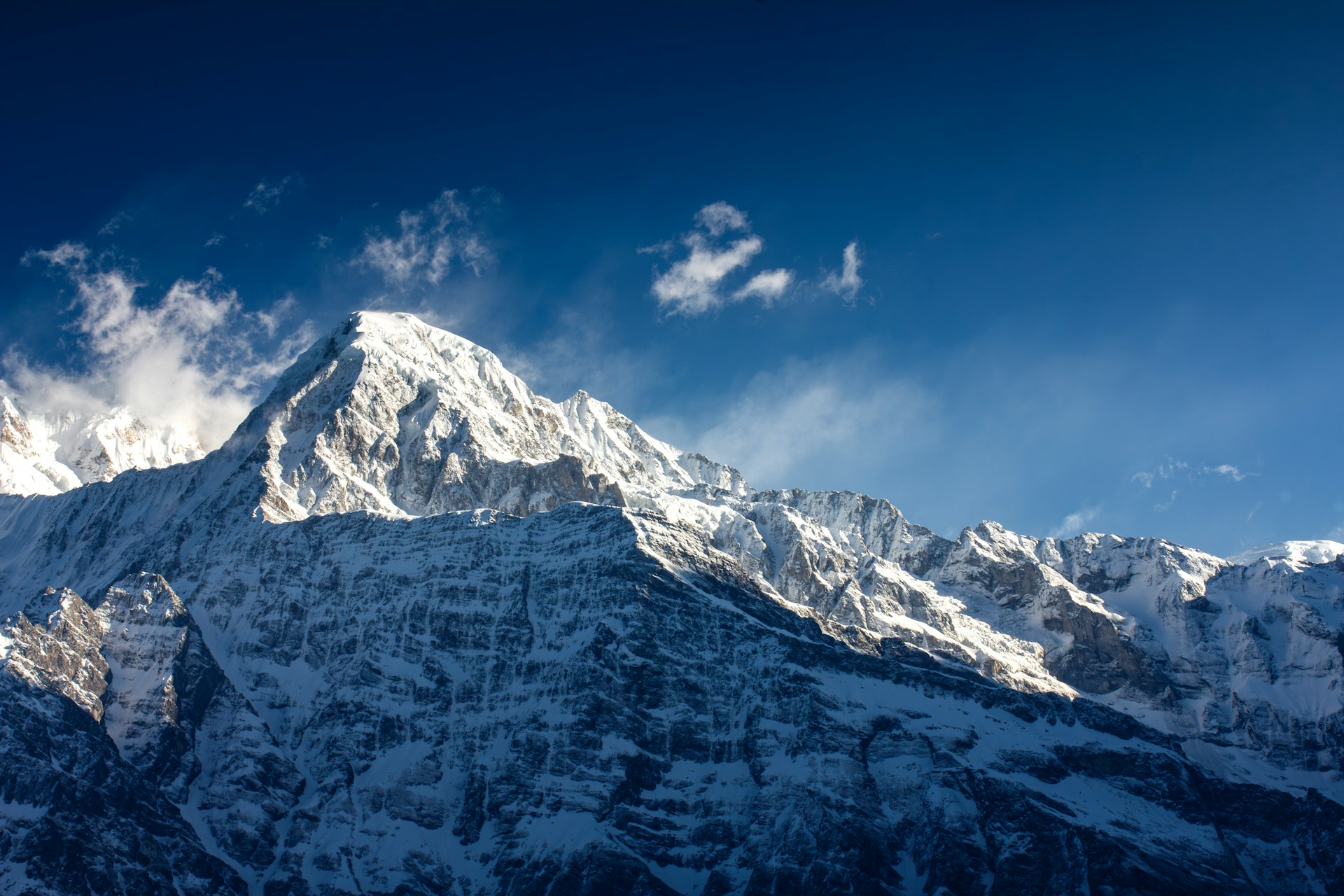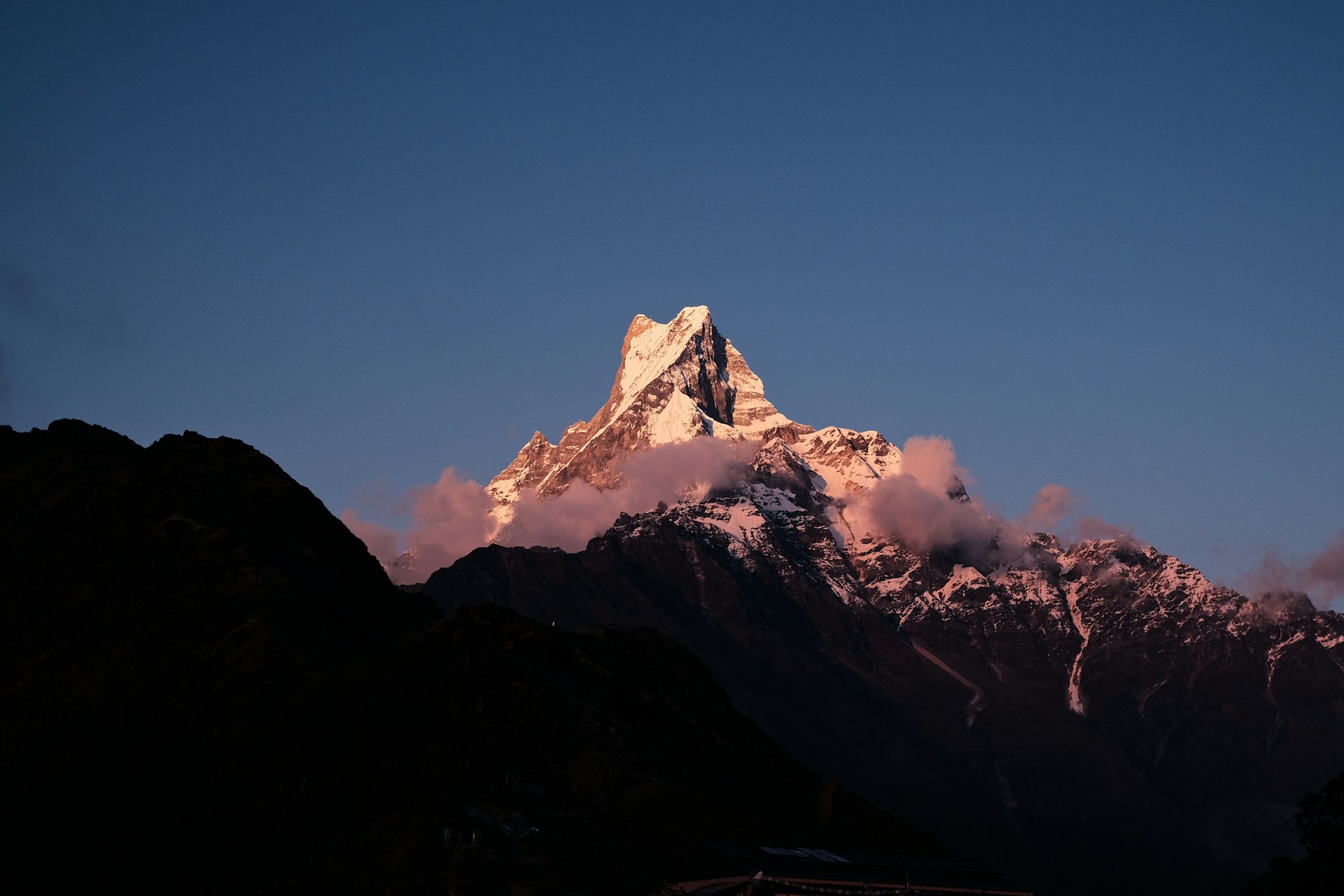Mardi Himal: Complete Seasonal Guide

Introduction: Discover Mardi Himal
Mardi Himal is a beautiful mountain in the Annapurna region of Nepal. At 5,587 meters (18,340 feet), it is shorter than Annapurna or Machapuchare (Fishtail Mountain), but it provides stunning views and a fun trekking experience. Mardi Himal is part of the Annapurna Conservation Area and is close to Pokhara. This makes it easy to get to and full of natural beauty and quiet trails.
The Mardi Himal trekking route is popular because it combines moderate high-altitude trekking with breathtaking scenery. Hikers go through rhododendron forests, alpine meadows, and small villages before getting to the Mardi Himal Base Camp.
This trek is great for people who want to see the Himalayas but don’t want to climb the hardest peaks. The trails are well-marked, and the climb allows for proper acclimatization for trekking. While walking through quiet forests and beautiful ridges, trekkers can see Machapuchare, Annapurna South, Hiunchuli, and other snow-capped peaks.
We will talk about the Mardi Himal trek itinerary, route, gear, and tips for trekking in the next few sections. This will help you plan your trip with confidence. The Nepal Mardi Himal trek is an unforgettable Himalayan experience to experience, whether you are a beginner or an experienced trekker. The views of the mountains and the landscapes are breathtaking.
Mardi Himal Overview & Location
Mardi Himal is a beautiful peak in the Annapurna region of Nepal Himalayas. It is 5,587 meters (18,340 feet) tall and is known for its peaceful trails, stunning forests, and views of the mountains from all sides. Even though it is smaller than Annapurna South or Machapuchare (Fishtail Mountain), it is a great place for both beginners and experienced trekkers to go.
The mountain is in the Mardi Himal district, close to Pokhara, and is part of the Annapurna Conservation Area. Its location makes it easy to get to, but it still feels far away. Along the way, there are beautiful ridges, alpine meadows, and rhododendron forests. Trekkers often enjoy views of Machapuchare, Annapurna South, Hiunchuli, and other snow-capped peaks as they approach the Mardi Himal Base Camp.
Quick Overview of Mardi Himal Location and Features:
- Region: Annapurna region, western Nepal
- Height: 5,587 meters (18,340 feet)
- Nearby Peaks: Machapuchare / Fishtail, Annapurna South, Hiunchuli
- Base Camp Altitude: Around 4,500 meters
- Starting Point: Pokhara trekking route
- Within: Annapurna Conservation Area
The Mardi Himal trekking route goes through traditional villages, thick forests, and beautiful ridges before getting to the base camp. Australian Camp is a popular stop for trekkers along the way because it has some of the best panoramic views of the Himalayas in the area, all of these are reasons which makes Mardi Himal Trekking a must-do-short trek in Nepal.
For a safe and comfortable journey, travelers often book through a trusted guide or agency in Nepal like Skyline Treks, who handle logistics, permits, and provide expert guidance.
Trek Difficulty, Elevation & Duration
The Annapurna region of Nepal is home to the popular Mardi Himal trek. It has amazing views of other snow-capped peaks, like Machapuchare (Fishtail Mountain) and Annapurna South. The highest point at Mardi Himal Base Camp is 5,587 meters (18,340 feet), making it a good place for both new and experienced trekkers to go on a moderate high-altitude trek.
Trek Difficulty:
- Considered moderate, not extremely technical.
- You need to be in good shape and have a lot of energy for long days of trekking.
- There are some steep slopes, alpine ridges, and parts of the trail that go up and down.
- Glacier crossings are not part of this trek, making it accessible to most trekkers.
Elevation:
- Starting point: Around 1,000 meters near Pokhara.
- Key stop: Australian Camp at about 2,000–2,700 meters.
- Highest point: Mardi Himal Base Camp at 5,587 meters.
- Proper acclimatization for trekking is important to prevent altitude sickness.
Duration:
- Standard trek duration is 5–7 days, depending on pace and itinerary.
- Some travelers extend the trek to 8–10 days or even more of 17 days – Mardi Himal Peak Climbing to include rest and extra viewpoints.
- Daily trekking ranges from 4–7 hours, allowing time to enjoy panoramic Himalayan views and local villages.
Joining a reliable agency like Skyline Treks is a good idea for first-time trekkers or people who need help. It will make the trip go more smoothly, keep you safe, and make it more fun.
The Mardi Himal Nepal trek is a great choice for people who want to see the Himalayas without having to deal with really hard mountaineering problems. It has a moderate level of difficulty, a reasonable altitude, and amazing views.
Seasonal Guide for Mardi Himal Trek
The Mardi Himal trek in Nepal’s Annapurna region is a beautiful adventure at a high altitude. Choosing the right season is important for safety, comfort, and seeing the best sights along the way.
Spring (March–May):
- Weather: Moderate temperatures, mostly clear skies.
- Highlights: Rhododendron forests bloom with bright red, pink, and white flowers.
- Views: You can see Machapuchare (Fishtail Mountain), Annapurna South, and Hiunchuli clearly.
- Tip: Bring layers for the mornings when it’s cold and the afternoons when it’s warm.
Autumn (September–November):
- Weather: Dry trails, stable skies, and cool temperatures.
- Highlights: Crisp air offers the best panoramic Himalayan views.
- Views: Snow-covered peaks and colorful landscapes.
- Tip: This is the busiest time of year, so it’s best to book early with a reliable Nepalese travel agency like Skyline Treks.
Winter (December–February):
- Weather: Cold temperatures, occasional snowfall, and strong winds.
- Views: Clear, crisp mountain scenery, but trekking is more challenging.
- Tip: Suitable only for experienced trekkers prepared for cold conditions.
Monsoon (June–August):
- Weather: Heavy rainfall and slippery trails.
- Views: Clouds may block mountain scenery.
- Tip: Don’t go trekking during this time of year because it’s dangerous, there are landslides, and you can’t see well.
No matter what time of year it is, it’s important to acclimatize properly before going trekking to avoid getting sick from the high altitude. Following the seasonal guide will help you have a safer and more fun trip through alpine forests, ridges, and villages on your way to the Mardi Himal Base Camp. For a more detailed and comprehensive guide do check out our Mardi Himal Trekking for Beginners: Tips and Advice blog.
Seasonal Tips & Preparation
The Mardi Himal trek has beautiful and stunning mountain views to see, but you need to plan ahead to have a safe and fun trip. Knowing what the weather will be like and getting ready for it helps hikers deal with trails at high altitudes and changing weather.
Seasonal Tips:
- Spring (March–May):
- Ideal for rhododendron forests in full bloom.
- Most of the time, the trails are clear, but it can be cold in the mornings.
- Layered clothing is recommended for fluctuating temperatures.
- Autumn (September–November):
- Most popular trekking season with dry trails and clear skies.
- Great for seeing the Himalayas from all angles.
- Book through agencies like Skyline Treks early.
- Winter (December–February):
- Cold temperatures and occasional snow.
- Only suitable for experienced trekkers with warm gear.
- Monsoon (June–August):
- Heavy rainfall, slippery trails, and landslide risks.
- Not recommended for trekking.
Preparation Tips:
- Fitness: Do cardio, hiking, and strength training to get ready for walking every day.
- Gear: Bring warm clothes, trekking boots, trekking poles, and other things you need for high-altitude trekking.
- Acclimatization: Follow rest days on the itinerary to adjust to altitude and prevent sickness.
With the right seasonal planning and preparation, the Mardi Himal Nepal trek becomes safer, more comfortable, and more fun. This lets trekkers focus on the stunning scenery and the experience of being in the mountains.
Travelers who have less time or want an easier alternative can also try doing Mardi Himal Helicopter Tour which provides you with breathtaking and stunning views quickly and comfortably in a helicopter from up high above.
Experience & Views During Each Season.
The Mardi Himal trek is a one-of-a-kind experience with breathtaking mountain views all year long. Knowing what each season has to offer helps trekkers choose the best scenery, comfort, and safety.
Spring (March–May):
- Experience: Walk through vibrant rhododendron forests filled with colorful flowers.
- Views: Clear vistas of Machapuchare (Fishtail Mountain), Annapurna South, Hiunchuli, and other snow-capped peaks.
- Tip: The weather is nice for trekking during the day, but it is still cold in the mornings.
Autumn (September–November):
- Experience: The trails are dry and the weather is calm, making hiking easy and fun.
- Views: Crisp, panoramic Himalayan scenery with excellent visibility of distant peaks.
- Tip: This is the busiest time of year, so make sure to book your lodging ahead of time.
Winter (December–February):
- Experience: The trails are quieter and there are fewer people on them, making for a peaceful Himalayan adventure.
- Views: Snow-covered landscapes and crystal-clear mountain views, but the cold can be extreme.
- Tip: Only for trekkers with proper cold-weather gear and experience.
Monsoon (June–August):
- Experience: Lush, green landscapes with flowing streams and waterfalls.
- Views: Mountain views may be hidden behind clouds and rain.
- Tip: Not recommended due to slippery trails and landslide risks.
No matter what time of year it is, trekkers who make it to Mardi Himal Base Camp and Australian Camp will be rewarded with breathtaking views of Machapuchare and the peaks around it. You can enjoy the beautiful scenery all year round if you join a reputable agency like Skyline Treks.
Tips, Safety & Conclusion
Trekking Mardi Himal in Nepal’s Annapurna region is an exciting adventure, but you need to be safe and ready for it to be a fun and successful trip. You can make sure you reach the top and enjoy the beautiful trails by following these tips and taking the right safety measures.
Essential Tips for Trekkers:
- Train in Advance: To get ready for daily treks at high altitudes, do cardio, hiking, and strength training.
- Pack Smart: Bring gloves, trekking poles, boots, and other things you need for high-altitude trekking.
- Acclimatize Properly: Take rest days as per the itinerary to avoid altitude sickness and adjust to higher elevations.
- Hydrate and Eat Well: To keep your energy up, drink a lot of water and eat meals that are high in energy.
- Use Professional Guides:Agencies like our Skyline Treks have experienced guides, take care of all the permits for you, and make sure everyone is safe along the way.
Safety Guidelines:
- Before you go on a trek or try to reach the summit, always check the weather.
- When climbing steep hills or alpine ridges, follow the guide’s instructions.
- Watch for signs of altitude sickness and go down right away if you need to.
- Use climbing and trekking gear properly, including trekking poles and boots with good grip.
Conclusion:
The Mardi Himal trek offers breathtaking views of Machapuchare (Fishtail Mountain), Annapurna South, Hiunchuli, and other peaks. From walking through rhododendron forests to reaching Mardi Himal Base Camp, the journey is rewarding and memorable providing you with countless amazing memories to hold onto.


